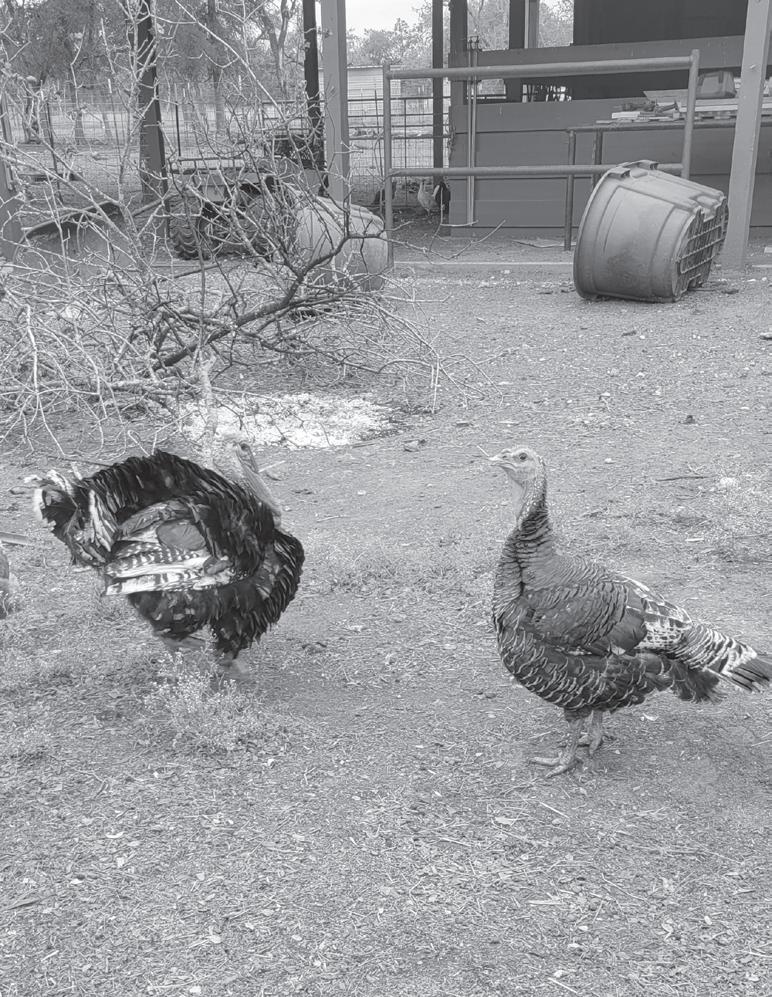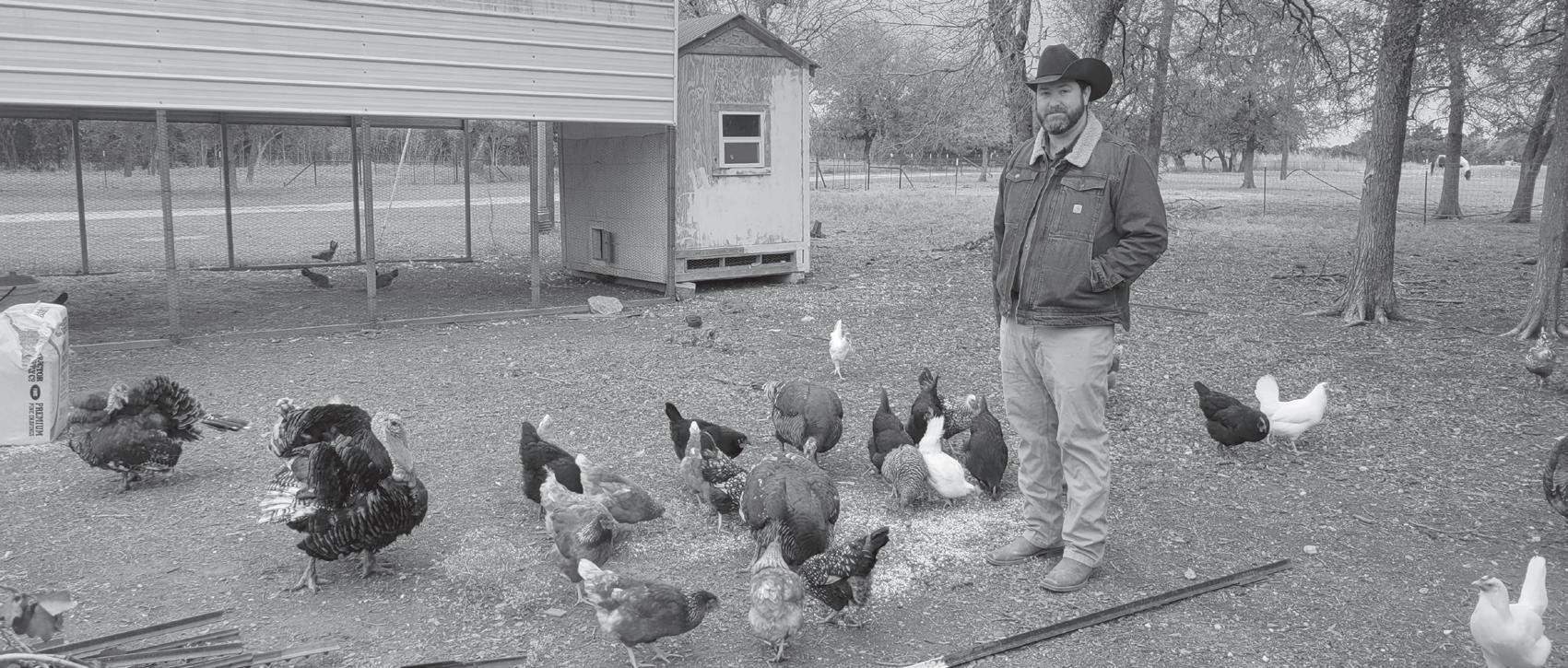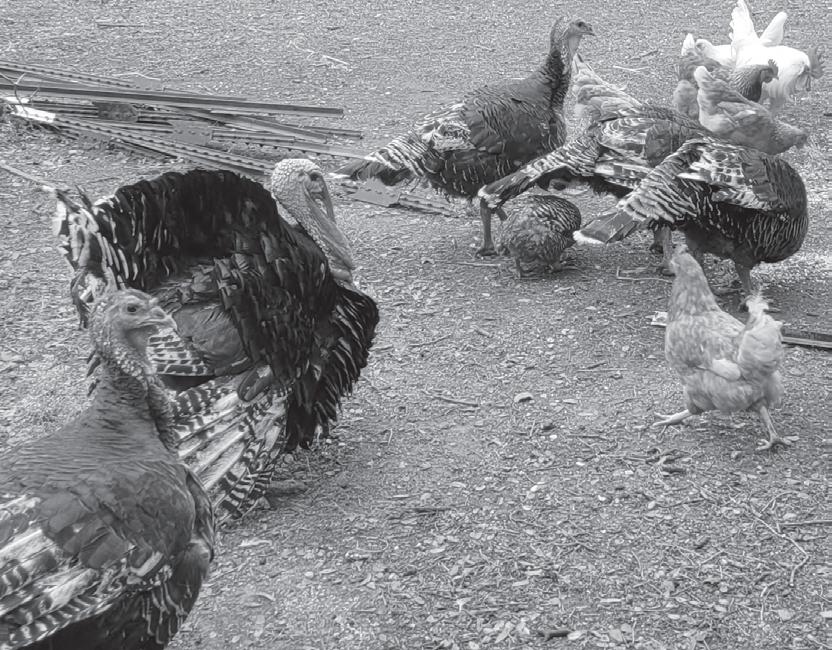
6 minute read
TALKING TURKEY
Turkey time
Local farm raises poultry all year to sell for holiday tables
BY RACHEL MADISON, STAFF WRITER

(Top) A Liberty Hill turkey farm is home to heritage bronze turkeys that are raised free-range, giving them more space to grow and interact. (Above) Grouchy Goat Farms owner Justin Rosewell says turkeys only breed in the spring with a hen laying up to 20 eggs. Once placed in incubators, eggs sit for about 30 days at 100 degrees until they hatch. PHOTOS BY RACHEL MADISON
At Grouchy Goat Farms in Liberty Hill, you will definitely see your fair share of goats. Horses, pigs, chickens and ducks, too. But amongst all the typical farm animals, you will also get to see something a little out of the ordinary for Central Texas—a flock of turkeys.
Justin and Lindsey Rosewell, owners of Grouchy Goat Farms, added turkeys to their farm about six years ago when they realized more and more people were turning back to farmers to source their food. And during COVID, that notion got even more popular.
“Raising turkey got big during COVID because of a nationwide turkey shortage,” Justin Rosewell said. “I started out doing about 50 birds for customers each year, but in 2021, we did our biggest year ever with 200 birds.”

Justin Rosewell of Grouchy Goat Farm in Liberty Hill feeds his flock. Rosewell said it takes about eight months for turkeys to grow to the desired weight in time for holiday butchering. PHOTO BY RACHEL MADISON
The Rosewells raise heritage bronze turkeys because they can actively lay fertilized eggs and hatch them. Broad breasted white turkeys, which are the most popular type of turkey found at grocery store chains, can’t breed because they are too large. That’s why those birds are typically raised by large commercial poultry operations, because they can be artificially inseminated, while some of the smaller, but more flavorful, breeds are raised by farmers and homesteaders.
“The heritage bronze breed was bred in the 1800s,” Justin Rosewell said. “Back then, chickens weren’t considered table fare. People bred chickens for eggs, and turkeys were what people had on their tables. Nobody really ate chickens.”
The Rosewells free range their turkeys, which gives them more space to grow and interact. While turkeys can be more susceptible to parasites than chickens, raising turkeys has many similarities. If you’ve raised chickens before, then you can raise turkeys, but you can’t treat turkeys like chickens, Rosewell said. You have to cater to them a little more.
Turkeys struggle in both extreme hot and extreme cold temperatures. During the summer months, Rosewell puts out large, shallow pans of water the turkeys can use to splash themselves and stay cool. When poults (baby turkeys) are born, they are kept in a brood house with heat lamps on them all day and night for their first three weeks of life.

Turkeys are very clean birds, Rosewell says, constantly grooming themselves and fluffing their feathers. PHOTO BY RACHEL MADISON
Turkeys only breed in the spring, Rosewell said. Each hen can lay up to 20 eggs, as long as Rosewell gathers the eggs daily and moves them into an incubator. Hens typically lay their eggs between March and May. Once the eggs are placed in the incubators, they sit for about 30 days at 100 degrees and 50 percent humidity until they hatch.
Rosewell hatches between 150 to 200 each spring. He keeps a few to replenish his own flock, but the majority of the birds are sold on a reservation system for holiday tables later in the year. Once the poults hatch, it takes about eight months for them to get to the right weight for butchering, Rosewell said.
He keeps track of his turkeys’ weights by pulling a sample of birds weekly to do a weigh in called adjusted daily gain.
“As long as their adjusted daily gain is about .2 pounds per day, then I don’t start messing with supplementing their feed. We watch their weights and when each bird gets around 22 pounds, it’s time to kill it. That way it will dress out for the holiday table at about 16 to 18 pounds, which is the size most people want at the grocery store.”
Rosewell processes every single turkey himself.
“What I see people is exactly like what you get at H-E-B,” he said. “I sell it by the pound, and I vacuum pack all of them and they come frozen just like at the store.”
In order to process the birds himself, Rosewell had to be inspected by a health inspector, and have all the proper permits and licenses that a butcher would have.
Rosewell said most people like knowing how their birds have been raised and what they’ve eaten, especially in the Austin area.
“If you can find a good market and cater to that market, then you will sell out of everything,” Rosewell said. “We’ve found that people have gotten away from going to the grocery store and are going back to the farmers and buying direct from producers. It’s better food, better business for the local economy, and you know the quality of what you’re getting. A lot of times, you can even seen the animal you’re going to buy while it’s still alive.”
It takes Rosewell between 30 to 45 minutes to process a single bird. He processes all of the turkeys in early October so they can be to his customers in time for the Thanksgiving and Christmas holidays. Rosewell uses a commercial scalding pot and plucking machine which expedites the process significantly, he said.
“You want to scald and pluck them immediately after they die, before they get into any rigor,” Rosewell said. “You don’t want to process or pack them while they are in rigor or they won’t taste right.”
Rosewell added that the butchering and processing portion for turkeys can be a big learning curve, and many people who farm don’t want to be part of that process. In that case, those farmers typically sell live poultry to butchers and have them do the work instead.
Turkeys are more friendly than most other types of poultry, Rosewell said, adding that its probably because they are the largest bird in the poultry family.
“They are the only breed of poultry you can come outside and have a conversation with,” he said. “They’ll talk back to you. They are very friendly and have interesting personalities—they are their own unique animal.”
Turkeys are very clean birds, constantly grooming themselves and fluffing their feathers, and the toms are known for always strutting.
“They are constantly strutting and putting on a show,” Rosewell said. “I’m not sure who they are putting on a show for, but they always are.”
To learn more about turkey farming, or to find recipe ideas for preparing a holiday bird, visit Grouchy Goat Farm’s website and blog at www.grouchygoatfarms.com.









